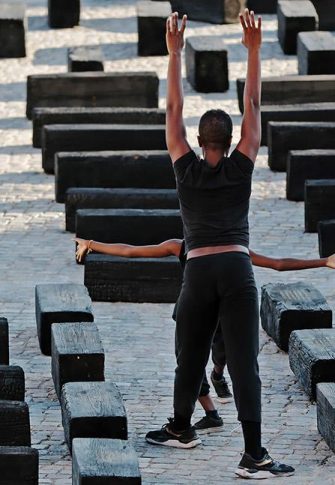The Centre for the Less Good Idea
27.09 - 27.09.2024
The room was quiet as artist Penny Siopis systematically prepared her materials. She diluted red ink in a bucket of water and opened one of the few bottles of standard woodworking glue that had been laid out. She considered the large blank canvas lying flat on the floor in front of her, seemingly making a decision before picking up the bucket, splashing the diluted ink onto the canvas in one, practiced motion. She watched the ink pool in one corner of the canvas and joked with the audience, saying that it meant the floor was uneven. This was the beginning of Siopis’ art demonstration and talk-through at The Centre for the Less Good Idea on the 27th of September.
The audience watched as the painting slowly unfurled, with Siopis guiding us through her process. She spoke about horizontality: the fact of the canvas being flat on the ground as opposed to being propped up on an easel. The relationship between the paint and the canvas is transformed – instead of ink flowing downwards, pulled towards the ‘bottom’ of a canvas by gravity, horizontality allows for the ink to behave in a different way. Instead of drips, one gets pools and dams of colour. The same can be said for the glue that Siopis used.
There is a distinct physicality to Siopis’ art practice. At one point, she placed her hand into a puddle of glue that had formed on the surface of the canvas and spread it in a way that made more sense to her. She pressed down on one corner of the canvas and the ink pooled around her finger, creating a small lake. Once she removed the pressure on the canvas, the ink flowed back to where it had originally settled. Due to the scale of the painting, she had to crawl along the canvas to reach its middle.
Alongside this performative painting, a video projection showed footage of her painting, using a chain suspended from the ceiling of a building to drip paint and glue across a flat canvas. The process was not unlike what Siopis was doing in situ. It showed how Siopis uses physicality, gravity and relationality to compose her artworks. That canvas was also presumably large and its centre hard to access — she came up with an ingenious method; using chains suspended from the ceiling, relics of the room’s previous purpose, to reach the painting’s centre. This dichotomy was interesting – the viewer was seeing her paint live while also watching a different aspect of her process in a digital format. In the video, there were close-up shots of the bucket of glue/paint suspended by chains, swinging across the room. The actual painting was never revealed and the canvas never shown.
Siopis’ method of abstraction allows her to consider representation with a sense of freedom. The foreground and the background, which are often so integral to figurative painting, are slightly less well-defined in Siopis’ works. In the same vein, she hesitates to call what she paints ‘figures’. Instead, they are her ‘creatures’, as distinct from specific human beings — they could be representative of anyone, anything.
This rejection of standardised expectations for artworks to have ‘figures’ and ‘backgrounds’ emphasises Siopis’ reliance on chance. She begins with drips of ink, pools of glue, and splatters of colour – what they morph into is dependent on gravity and chemical reactions. Siopis seems to prefer formlessness and abstraction, not held back by the edges of the canvas, accidental hard lines, and what she calls the ‘skin’ of the painting.
This is somewhat in contrast to her short films, a selection of which was shown after her painting process was complete. To create her films, Siopis uses found old-fashioned film reels. Often, the figure and background are clearly defined and are used in a completely different way, with the artist creating narratives by splicing and rearranging the footage in a manner that serves her purpose.
Watching Siopis paint in front of me was a different experience from seeing works displayed in a gallery. Here, the artist was in action, dispelling some of the mystery that can come with artmaking — the thought processes behind each of her paintings were crystalised.









